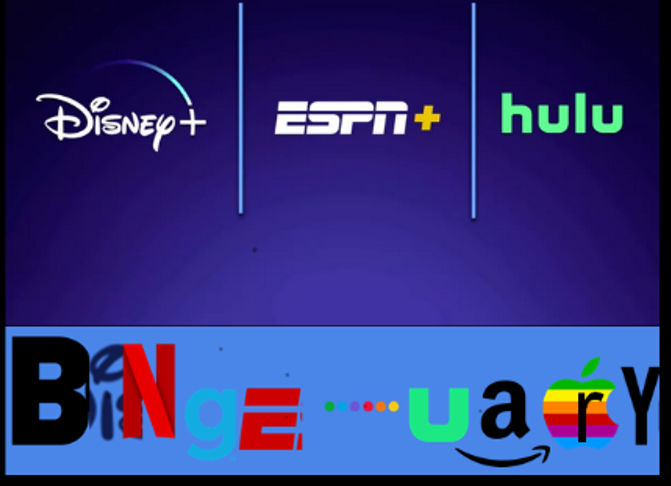
By Andrew Jenck
The Walt Disney Company has produced countless cultural touchstones, but when compared to the other major studios, it was considered smaller, or at least a narrower appeal, before the 2010s. While Touchstone Pictures, ABC, and ESPN produced content for a more mature audience, Disney still largely ran on animation and theme parks. When Bob Iger was appointed CEO in 2005, he set out to branch Disney out to be a true multi-media conglomerate. Every major acquisition made under Iger has been an industry-leader in an attempt to stay relevant; whether it be CGI animation, super heroes, or revivals of popular film series. Now that streaming is the big source of revenue in Hollywood, and with its recent purchase of 21st Century Fox, Disney’s film and television library is so large and diverse that it can’t fit onto one platform.
Disney+ is only the surface of Disney’s business model going forward. Whereas all the other major studios are going for an all-in-one approach, Disney is dividing and conquering. The Fox acquisition also came with a majority stake and soon to be wholly-owned share of Hulu. ESPN meanwhile launched its own direct-to-consumer service in 2018. Bearing its brand name, Disney+ can only appeal to families, and while family entertainment is the most valuable demographic, that alone would have them miss out on the more mature content revenue. You don’t like the Disney aesthetic? Hulu may have something for you. Any adult-oriented programming will be placed on Hulu, such as several original series produced by FX Productions. Put simply, you will get The Simpsons and Malcolm in the Middle on Disney+ but get Family Guy and The X-Files on Hulu.
Price wise, the cost is shockingly reasonable. You get Disney+ for $6.99 a month or $69.99 annually, or a bundle with ESPN+ and the ad-supported Hulu for $12.99/month. These prices were shocking to me, as Disney is notorious for being expensive in just about everything, but here’s the thing: the bundle is the same price as Netflix. Disney realizes that in order to compete with Netflix, it needs to be seen as the more budget-friendly option. Whereas you need the premium plan to get four screens on your Netflix account, Disney+ has four screens at its base price. In addition, Disney is a studio that can afford to be more expensive with its programming as everything is a safe bet. Season 1 of The Mandalorian, the first live-action Star Wars TV series, cost $120 million, and The Falcon and the Winter Soldier is estimated to cost $150 million.
So much is being put into streaming that Disney is starting to ease back on theaters. As other insiders have pointed out, Disney mainly released its biggest tentpole franchises in 2019 to promote the strength of the brand and make Disney+ more appealing. On the Fox side of the company, the amount of films released is diminished and half of those will be released straight to streaming. Movies may be making a billion dollars more often than ever, but it’s not the most stable approach for long term success anymore as fewer people are going to the theaters i.e. Spider-Man: Far From Home is the highest grossing Spidey movie but Spider-Man (2002) remains the most attended.
This is not only the appeal of streaming but also of direct-to-consumer products in general. Disney gets fewer viewers by setting off on their own, but the $200 million they’re making this month is going directly to them. The 1948 Supreme Court case United States v. Paramount Pictures, Inc. ruled that movie studios could not own movie theaters, but with streaming, studios can now avoid these restrictions and charge exclusive content at any price they see fit.
The Mickey Ear invasion of Hollywood has been a gradual one to the point where we’re only now noticing it. I remember when the Fox shows, ESPN 30 for 30, and the Disney blockbusters were among the most prolific of Netflix’s offerings, and now they’re taking it back for themselves. All of the most lucrative release dates, some of the most established IPs, and the greatest cinematic tools are now under Disney’s roof. Even one major studio executive has stated that it is “impossible” to compete with Disney head on and success can only be found in gaps between Disney blockbuster releases or releases of more moderate budget films on those same weekends. The name of the game in Hollywood is media consolidation, i.e. MGM is reportedly looking to be acquired by Apple, Netflix, or others. I can’t fully predict the entertainment landscape ten years from now, but I do know this: Disney will always have an edge as the family-oriented company they’ve always been but now with more appeal to other demographics.
For more about Bingeuary, here are links to Andrew’s other editorials:
https://www.tillamookcountypioneer.net/drews-reviews-editorial-streaming-in-the-2020s/
https://www.tillamookcountypioneer.net/drews-reviews-editorial-hbo-maximized-dcu-minimized-streaming-services-series-continued/
https://www.tillamookcountypioneer.net/drews-reviews-editorial-cbs-all-lacking-streaming-services-series-continues/
https://www.tillamookcountypioneer.net/drews-reviews-editorial-not-a-flightless-bird-streaming-services-series-continued/
https://www.tillamookcountypioneer.net/drews-reviews-editorial-taking-a-bite-streaming-services-series-continued/


